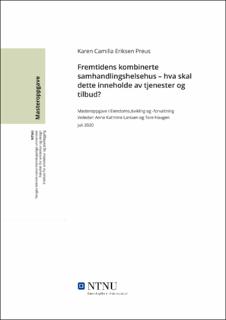| dc.contributor.advisor | Larssen, Anne Kathrine | |
| dc.contributor.advisor | Haugen, Tore | |
| dc.contributor.author | Preus, Karen Camilla Eriksen | |
| dc.date.accessioned | 2021-09-28T17:24:16Z | |
| dc.date.available | 2021-09-28T17:24:16Z | |
| dc.date.issued | 2020 | |
| dc.identifier | no.ntnu:inspera:58784277:21520550 | |
| dc.identifier.uri | https://hdl.handle.net/11250/2784295 | |
| dc.description.abstract | Det utredes og etableres stadig flere helsehus i Norge, og byggene blir utviklet av både offentlige og private aktører. Denne masteroppgaven ser nærmere på hva som ligger bak en slik etablering, hvordan helsehusene fungerer og hva slike helsehus inneholder av tjenester og tilbud. Videre vil jeg se nærmere på hvordan man kommer frem til valgt konsept gjennom tidligfasevurderinger og mulighetsstudier.
Masteroppgavens problemstilling er som følger:
«Hva skal fremtidens kombinerte samhandlingshelsehus inneholde av tjenester og tilbud?».
Det er utarbeidet tre forskningsspørsmål for å besvare valgte problemstilling:
1. Hvilke typer helsehus finnes i Norge i dag?
Her vil det redegjøres for hvilke type helsehus det finnes i Norge i dag og hvordan disse er organisert mht. eierform, innhold, osv. Bakgrunnen for etableringen av slike hus vil bli belyst ut ifra de funn som gjøres i oppgaven.
2. Hvordan fungerer samarbeidet mellom de ulike helseaktørene innenfor disse helsehusene? Og, finnes det et samarbeid?
Her vil det redegjøres for om det finnes et samarbeid i dag og om hvordan dette samarbeidet fungerer. Videre vil det avklares om hvilke føringer som eventuelt ligger bak et slikt samarbeid.
3. Hva er viktige faktorer ved etablering av nye kombinerte samhandlingshelsehus?
Her vil det gås inn på hvilke faktorer som vil ligge til grunn for at det skal etableres nye kombinerte samhandlingshelsehus, og hvilke prosesser og tiltak som må gjennomføres før et slik bygg kan bli etablert.
Oppgavens resultater er innhentet ved bruk av ulike kvalitative metoder; så som litteratur- og dokument studie, sammenlignende casestudie og dybde- og fokusintervjuer. Det sammenlignende casestudie tar for seg 3 eksisterende kombinerte samhandlingshelsehus, og dybde- og fokusintervjuene (totalt 6 stykk) er gjennomført med aktører som utvikler helsehus og av leietakere i ulike helsehus i Norge.
Fremtidens kombinerte samhandlingshelsehus bør ha som intensjon at det skal kunne møte de utfordringer som vil møte helsevesenet i fremtiden som dagens primær- og spesialisthelsetjeneste ikke er rigget for. Vi vil oppleve befolkningsvekst og det vil skje en demografisk endring mot at det vil bli flere eldre og at man lever lengre. Fremtidens kombinerte samhandlingshelsebygg må tilpasses disse endringene, og tjenestene må tenke mer helhetlig og at pasienten settes i fokus – til enhver tid. | |
| dc.description.abstract | Several health centre buildings are being thorough investigated and established in Norway, and the buildings are being developed by both public and private actors. This master's thesis will look more closely at what lies behind the establishment of such health centre buildings, how it works and what such health centre buildings contain of services to the public. Furthermore, I will look more closely at how to conclude to the chosen concept through early phase assessments and feasibility studies.
The purpose of this master thesis is to reveal: "What will the combined health centre building contain of services in the future?".
On the basis of the purpose of this thesis there has been developed three research questions which will be answered:
1. What kind of health centre buildings exist in Norway today?
In the master thesis it will be explained what kind of health centre buildings exist in Norway today and how these are organized with regards to health care, form of ownership, content, etc. The underlying cause of the establishment of such buildings will be elucidated from the findings made in the thesis.
2. How does the collaboration between the various health actors within these health centre buildings work? And, does it exist any collaboration?
There will be explained if there is a collaboration and how this collaboration works. Furthermore, it will be clarified about the guiding principles, if any, behind such cooperation.
3. What are important factors in establishing new combined interaction health care buildings?
The factors that will form the basis for the establishment of new combined health centre buildings will be discussed, and what processes and measures must be implemented before such buildings can be established.
The results of the master thesis are obtained using various qualitative methods; such as literature and document study, comparative case study and in-depth and focus interviews. The comparative case study deals with 3 existing combined interaction health centres, and the in-depth and focus interviews (a total of 6 pieces) were conducted with actors who develop health homes and tenants in different health centre buildings in Norway.
The future of the combined interaction health centre buildings should have the intention that it will be able to meet the challenges that will meet the healthcare system in the future for which today's primary and specialist health services are not rigged. We will experience population growth and there will be a demographic change towards the fact that there will be more elderly people and recidents will live longer. The future combined health centre building must be adapted to these changes, and the services must think more holistically and that the patients are always in focus. | |
| dc.language | | |
| dc.publisher | NTNU | |
| dc.title | Fremtidens kombinerte samhandlingshelsehus – hva skal dette inneholde av tjenester og tilbud? | |
| dc.type | Master thesis | |
